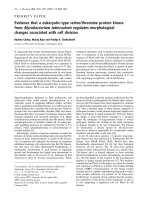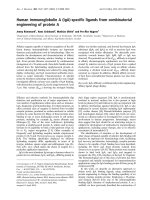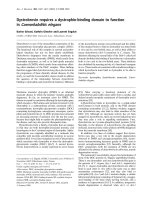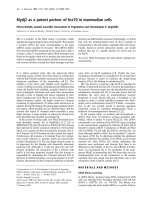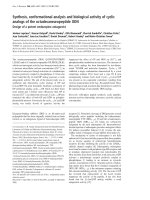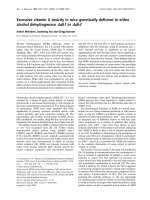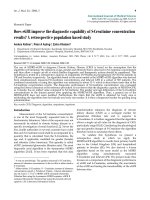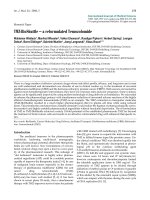Báo cáo y học: "Intramuscular Olanzapine – a UK case series of early cases" ppsx
Bạn đang xem bản rút gọn của tài liệu. Xem và tải ngay bản đầy đủ của tài liệu tại đây (210.59 KB, 5 trang )
BioMed Central
Page 1 of 5
(page number not for citation purposes)
Annals of General Psychiatry
Open Access
Case report
Intramuscular Olanzapine – a UK case series of early cases
Chris J Bushe*
1
, Mark Taylor
2
and Mathew Mathew
3
Address:
1
Eli Lilly and Company Ltd, Basingstoke, UK,
2
Springpark Centre, Glasgow G22 5EU, UK and
3
Stonehouse Hospital, Dartford, DA2 6AU,
UK
Email: Chris J Bushe* - ; Mark Taylor - ;
Mathew Mathew -
* Corresponding author
Abstract
Background: Clinical trials assessing efficacy and safety of Intramuscular (IM) Olanzapine in acute
schizophrenia and acute mania have previously been undertaken in studies required for drug
registration in patients who were required to give informed consent. These patients may have less
severe forms of psychosis than patients treated in routine practice. Data derived from naturalistic
practice following the launch of IM olanzapine may be helpful for clinicians in assessing efficacy and
safety of IM olanzapine. The PANSS-EC scale used in the clinical studies may represent a tool that
could be used in routine clinical practice.
Case presentation: We report on an early unselected case series of 7 patients who received IM
olanzapine in routine clinical practice settings in the UK. In this case series, olanzapine IM was
generally effective, and no adverse events were reported. Adjunctive benzodiazepines were given
concomitantly in 1 of the 7 subjects. This is relevant as concomitant benzodiazepines are not
recommended for a minimum of 1 hour post IM olanzapine administration. PANSS-EC data was
collected in 2 of the 7 subjects.
Conclusion: Although patients had greater severity of psychosis than clinical trial patients there
were no unexpected findings. In addition the PANSS-EC scale is a scale that may be useful in
assessing the efficacy of IM antipsychotics in routine clinical practice.
Background
During recent years more attention has been shown to
rapid tranquilisation for the treatment of acute agitation
in schizophrenia and bipolar disorder and the potential
problems associated with it [1,2]. The majority of patients
that require rapid tranquilisation have some form of seri-
ous psychosis and may also have physical problems such
as biochemical disturbances and dehydration [3,4]
For many years the standard treatments used were
droperidol and lorazepam [2]. Concerns over QTc prolon-
gation led to cessation of use of droperidol in the UK [5]
along with awareness that QTc prolongation could be
more severe in patients administered intramuscular typi-
cal medications [1]. Droperidol usage is no longer permit-
ted in the UK [5] and has been replaced in most instances
by haloperidol. However, the use of intramuscular
haloperidol is also well recognised to be associated with
acute dystonic reactions and other extrapyramidal side
effects [6,7].
Published: 1 April 2007
Annals of General Psychiatry 2007, 6:11 doi:10.1186/1744-859X-6-11
Received: 1 November 2006
Accepted: 1 April 2007
This article is available from: />© 2007 Bushe et al; licensee BioMed Central Ltd.
This is an Open Access article distributed under the terms of the Creative Commons Attribution License ( />),
which permits unrestricted use, distribution, and reproduction in any medium, provided the original work is properly cited.
Annals of General Psychiatry 2007, 6:11 />Page 2 of 5
(page number not for citation purposes)
Since Feb 2004 intramuscular olanzapine has been avail-
able in the UK and Europe and was the first licensed atyp-
ical available in Europe as a short acting intramuscular
formulation. Clinical trials suggested low rates of occur-
rence for any QTc prolongation and acute dystonic reac-
tions [1,7,8]. There were no differences found between
placebo and IM olanzapine in terms of QTc prolongation
from a pooled analysis of the IM olanzapine clinical trials.
Although IM olanzapine has been compared with placebo
and haloperidol in acute agitation [7] associated with
schizophrenia and with placebo and lorazepam in acute
agitation [8] associated with mania, the studies required
the patients to provide written informed consent to be
included. Patients entered into these trials were thus likely
to have had less severe forms of agitation than those who
would be treated in routine practice. Furthermore the
study of highly specific populations in randomised con-
trolled trials (RCTs) (i.e. agitation associated with mania
or schizophrenia) means that potential patients receiving
the drug in clinical practice would have been excluded
from RCTs for a variety of reasons including concomitant
substance abuse. Thus patients treated in clinical practice
are likely to be substantially different from those enrolled
in RCTs. Preliminary clinical data derived from patients
treated with IM olanzapine in a naturalistic setting may be
of interest to clinicians.
The PANSS-EC scale is derived as a subscale of PANSS
[9,10] and is a simple scale used to measure the degree of
agitation. It formed the primary study endpoint in each of
the main clinical IM olanzapine studies for registration
[7,8] and may be a useful tool for clinicians in routine
practice. The scale consists of 5 items (poor impulse con-
trol, tension, hostility, uncooperativeness, excitement)
each being ranked from 1–7 giving a potential maximum
score of 35 points.
We report on an early series of patients in whom intra-
muscular olanzapine was used and where in some cases
the PANSS-EC scores were recorded as routine practice.
Psychiatrists treating patients in Psychiatric Intensive Care
Units (PICU) and open wards in United Kingdom were
asked to report data from their initial cohort of patients
treated with IM olanzapine. The first 7 consecutive case
reports received from any UK clinician have been
included in this case series. These patients were treated in
2004–2005. Cases were reported informally to CB and
were consecutively reported. No cases have been
excluded. These patients represent an unselected group of
patients from units around the UK whom were treated
with IM olanzapine at a time when the predominant IM
medications being prescribed were haloperidol and
lorazepam.
Patients provided retrospective informed consent to the
anonymised use of their details. The data is reported in a
descriptive manner and no formal statistical analyses have
been performed. In those patients where PANSS-EC scores
have been measured this formed part of the routine
assessment of patients within that unit at the time.
Case presentations
Case 1
A 40-year-old woman with a diagnosis of bipolar illness
presented in an acute manic state. Previous but not cur-
rent medication included depot clopixol and lithium.
There was recent usage of heroin and other illicit drugs.
Current dosage of diazepam was 80 mg/day. After admis-
sion 2 doses of clopixol acuphase (75 and 100 mg respec-
tively) given over 5 days had little effect other than some
sedation. Immediately prior to being given IM olanzapine
10 mg her behaviour was loud, over familiar and intru-
sive. The patient requested an IM sedative and was not
detained under the Mental Health Act (MHA). Neither
concomitant benzodiazepines nor anticholinergics were
given. PANSS-EC scores shown in table 1. The nursing
staff reported the patient as being much "quieter" but not
asleep after 60 minutes. Following a single dose of intra-
muscular olanzapine, depot clopixol was reinstated with
valproate. No adverse events were reported.
Case 2
A 28-year-old woman with a diagnosis of schizophrenia
presented in a psychotic and uncooperative state refusing
medication. Medication prior to admission was 800 mg
quetiapine and 1 mg lorazepam daily. Her behaviour
became overtly aggressive including making a hole in the
hospital bedroom wall and attempted assaults on staff.
She was placed under the MHA and given IM olanzapine
10 mg. Neither concomitant benzodiazepines nor anti-
cholinergics were given. PANSS-EC scores shown in table
2.
Nursing observations showed that the patient was asleep
after 120 minutes post-IM (01.00) and remained "quieter
and more relaxed for the next 2 days". Patient feedback
was that she felt calmer after IM olanzapine. No adverse
events were reported by the patient or physician. Patient
Table 1: PANSS-EC scores of Case 1
Time (minutes) 0 30 60 120
PANSS-EC 24 8 8 6
Annals of General Psychiatry 2007, 6:11 />Page 3 of 5
(page number not for citation purposes)
however continued to refuse oral medications and cur-
rently receives depot risperidone.
Case 3
A 49-year-old woman with a long standing history of
bipolar affective disorder presented in a mixed affective
psychotic state having had no relapses for 2 years. Her pre-
vious medication regimens included citalopram, lithium,
valproate and lamotrigine. At admission her medication
was lamotrigine 100 mg. Her behaviour was reported as
"aggressive, confrontational and entertaining beliefs sug-
gestive of delusional jealousy and suspiciousness about
family".
Oral medication was refused and the patient was sec-
tioned under the MHA. IM olanzapine 10 mg was given
and no concomitant benzodiazepines or anticholinergics
were administered. Nursing staff reported a moderate
degree of tranquilisation (calm, relaxed and not sleeping)
and that confrontation was avoided. Little effect upon
delusional beliefs was noted. The patient began to engage
with staff within 36 hours post IM olanzapine and at
which stage oral olanzapine was accepted. No adverse
events were reported.
Case 4
An 18-year old male with a diagnosis of schizophrenia
was admitted in an acutely psychotic state under the
MHA. He refused oral medication and presented in an
extremely agitated state expressing paranoid delusions
such as "people have put fish bones in my food". He was
not currently on medication (although previously had
received olanzapine 10 mg orally) and was known to have
used illegal substances in the past. There was an addi-
tional forensic history. He was treated with 10 mg olanza-
pine IM and the nursing notes state, "he soon went to
sleep". Around 12 hours later he became agitated again
and barricaded himself in his room. He was given 10 mg
olanzapine IM and 2 mg IM lorazepam. The nursing notes
report that within 30 minutes he was "settled" and had
"calmed down". Around 2 hours post-injection he was
asleep. Subsequently he was transferred onto olanzapine
20 mg orally. No adverse events were reported.
Case 5
A 65-year old male with a diagnosis of schizoaffective dis-
order was admitted under the MHA in an extremely agi-
tated state and expressing suicidal ideation. There was
evidence of persecutory delusions. Around midnight he
received 10 mg olanzapine IM. No benzodiazepines were
administered. The nursing notes report that he "slept
well" and "settled" soon after medication. No concomi-
tant benzodiazepines were given. No adverse events were
reported.
Case 6
A 40-year old female with a diagnosis of bipolar disorder
was admitted in an acutely manic state. Her normal med-
ications included olanzapine 20 mg and sodium val-
proate. The nursing staff report that she was "restless,
agitated, verbally aggressive and had evidence of an ele-
vated mood". She was treated with 10 mg olanzapine IM.
The notes report that she settled after medication and
"slept undisturbed". No benzodiazepines were adminis-
tered. Within the first 24 hours after IM olanzapine she
was commenced on depot clopixol 200 mg/weekly. No
adverse events were reported.
Case 7
A 46-year old male with a 10-year history of schizophre-
nia was admitted in an acutely psychotic state. He had
relapsed having been changed from IM depot haloperidol
to risperidone LAIM. For the 2 weeks prior to admission
he had received additional oral risperidone and sodium
valproate He had showed features of paranoid and gran-
diose delusions together with elevated mood and had
been asked to leave work, as "colleagues could not under-
stand his talk". On admission, he was given a single injec-
tion of IM olanzapine 10 mg at around 18.00. No
concomitant benzodiazepines were administered. The
nursing reports state that "later that night he was no
longer laughing without reason and was quiet. He slept
well". The response was not maintained and he was
reported as grossly psychotic again at midday the next day.
No adverse events were reported.
Discussion
In general terms and acknowledging the limitation of
reporting only a small number of cases, our findings are
not dissimilar from the clinical trials. Responder rates in
the IM olanzapine RCTs at 2 hours post IM administration
were 63–80% in schizophrenia patients and 81% in bipo-
lar subjects [11]. In this review of 7 cases, the majority of
the patients received only a single IM olanzapine injection
without need for concomitant benzodiazepines or anti-
cholinergics as in the clinical trials, where these medica-
tions were commonly prescribed. In 5 of the 7 cases,
resolution of the behavioural symptoms was reported
soon after the initial treatment with olanzapine IM, and in
2 of those cases, a response was reported within an hour.
Table 2: PANSS-EC scores of Case 2
Time (minutes) 0 30 60 120
PANSS-EC 25 22 12 4
Annals of General Psychiatry 2007, 6:11 />Page 4 of 5
(page number not for citation purposes)
In 4 of the 7 cases patients were either acutely manic or
were reported as having schizoaffective symptomatology
with prominent mood symptoms. Only 1 of the 7 patients
needed more than one injection, which could be consist-
ent with the data from the mania RCT in which 26%
patients needed more than one olanzapine injection [8].
No spontaneous adverse events were reported in this
small naturalistic series.
The use of IM olanzapine as reported in this small number
of cases has not led to any unexpected findings. The
PANSS-EC scale is a quick and fairly routine scale to be
able to use in everyday clinical practice and usage has
been adopted by some UK clinicians. The falls seen in
PANSS-EC in this cohort however are individually greater
than those measured in the registration clinical trials. The
decreases in PANSS-EC at 120 minutes in our 2 patients
were 21 and 18 points respectively, which compares to a
mean decrease of 6 points in the clinical trials at the same
time point [7,8] There are a number of possible explana-
tions for this, which include better awareness of the
PANSS-EC scale by trial investigators with more accurate
measurements, or that greater decreases may be seen in
the naturalistic population studied who commence with
higher PANSS-EC scores. The mean PANSS-EC entry
scores in both the schizophrenia and mania IM agitation
studies were around 18 [7,8] This contrasts with 24.5
(range 24–25) in this small series. The difference in entry
PANSS-EC is not unexpected as the requirement for
informed consent in the clinical trials precludes enrolling
particularly hostile or oppositional individuals (as seen in
this naturalistic case series), which in turn would lead to
lower PANSS-EC scores. However even in this series not
all patients were detained under the MHA and in one case
even requested IM olanzapine treatment.
The use of benzodiazepines as either a primary or con-
comitant treatment is widely debated. The product license
for IM olanzapine in the UK requires that no patient
should receive benzodiazepines for at least 1 hour after IM
injection. Furthermore the product license states that
when benzodiazepines are being taken prior to admission
to hospital caution should be exercised when administer-
ing IM Olanzapine and appropriate clinical monitoring
should be undertaken in accordance with the olanzapine
product license. In this small group 1/7 patients had been
taking benzodiazepines immediately prior to admission,
and also in 1 other cases adjunctive benzodiazepines were
subsequently used. In this case, IM lorazepam 2 mg was
given at the same time as IM olanzapine and thus not in
line with the license which recommends not giving
adjunctive benzodiazepines for a minimum of 1 hour
post IM olanzapine injection. However in this individual
case, no adverse events were observed and the patient
received lorazepam after being given a second dose of IM
olanzapine having responded partially for a relatively
short period of time following the first dose.
The responder rates measured in the trials of IM olanzap-
ine and comparator treatments suggest that good rates of
response will be seen with only a single injection of any
active treatment (olanzapine, lorazepam, and haloperi-
dol). Similarly we observed in our series that good
responses were seen in moderately severely agitated
patients given mainly a single 10 mg injection of IM olan-
zapine. In our small series 6 patients responded well to a
single IM olanzapine injection. The response in the other
patient given 2 injections of IM olanzapine was poor ini-
tially with a short term response being maintained only
temporarily necessitating an additional injection.
Although data was being in some cases collected routinely
to assess PANSS-EC there was however no formal charting
collecting parameters like blood pressure and other vital
signs. With usage of IM olanzapine it is imperative that cli-
nicians adhere to recommendations made in the product
information with regard not only to dosages but also
safety monitoring.
The nursing observations and patient feedback in this
study were similar to the clinical trial observations that IM
olanzapine was associated with a calming effect with
rapid onset of action but with no evidence of over seda-
tion. Some patients are reported to have slept following
dosing but the medication was administered during the
night.
Nothing inconsistent with the data from the clinical trials
was observed despite there being a more severe degree of
agitation in our naturalistic population in at least some
patients as observed from the cases in which PANSS-EC
data was reported.
Key points
• The PANSS-EC scale is an easy to administer and easy to
record scale that might find use in the wider clinical set-
ting. The simplicity of the scale suggests that it could have
routine usage in PICU's and other wards where any intra-
muscular treatments for patients with acute psychosis are
used.
• Clinical monitoring as suggested within the olanzapine
product license to include cardiovascular and respiratory
parameters should also be routinely recorded.
Limitations
There are clear limitations to any interpretations of data
deriving from this small number of early case reports and
bias in the collection and reporting of the data cannot be
excluded.
Publish with BioMed Central and every
scientist can read your work free of charge
"BioMed Central will be the most significant development for
disseminating the results of biomedical research in our lifetime."
Sir Paul Nurse, Cancer Research UK
Your research papers will be:
available free of charge to the entire biomedical community
peer reviewed and published immediately upon acceptance
cited in PubMed and archived on PubMed Central
yours — you keep the copyright
Submit your manuscript here:
/>BioMedcentral
Annals of General Psychiatry 2007, 6:11 />Page 5 of 5
(page number not for citation purposes)
Competing interests
Chris Bushe is an employee of Eli-Lilly UK.
Dr M Taylor has received hospitality from various phar-
maceutical companies and has received fees for lecturing
for Eli Lilly UK
Authors' contributions
CB instigated the data collection and authored the initial
manuscript. MT and MM acquired the data and provided
further authorship input.
Acknowledgements
The manuscript was written by the named authors. No financial assistance
of any kind was provided by Eli Lilly. There are no other acknowledge-
ments. The production fee will be paid by Eli Lilly UK.
References
1. Lindborg S, Beasley C, Alaka K, Taylor C: Effects of intramuscular
olanzapine versus haloperidol and placebo on QTc intervals
in acutely agitated patients. Psychiatry Research 2003,
119:113-123.
2. Jones B, Taylor C, Meehan K: The efficacy of a rapid acting for-
mulation of intramuscular olanzapine for positive symp-
toms. J Clin Psychiatry 2001, 62(Suppl 2):22-24.
3. Battaglia J, Lindborg S, Alaka K, Meehan K, Wright P: Calming ver-
sus sedative effects of intramuscular olanzapine in agitated
patients. Am J Emerg Med 2003, 21:192-198.
4. Tesar G, Stern T: Evaluation and treatment of agitation in the
intensive care unit. J Intens Care Med 1986, 1:137-148.
5. Anonymous: QT prolongation with antipsychotics. Current prob-
lems in pharmacovigilance 2001, 27:4.
6. Glazer WM: Extrapyramidal side effects, tardive dyskinesia
and the concept of atypicality. J Clin Psychiatry 2000, 61(Suppl
3):16-21.
7. Wright P, Birkett M, David SR, Meehan K, Ferchland I, Alaka KJ, Saun-
ders JC, Krueger J, Bradley P, San L, Bernardo M, Reinstein M, Breier
A: Double blind placebo-controlled comparison of intramus-
cular olanzapine and intramuscular haloperidol in the treat-
ment of acute agitation in schizophrenia. Am J Psychiatry 2001,
158:1149-1151.
8. Meehan K, Zhang F, David S, Tohen M, Janicak P, Small J, Koch M, Rizk
R, Walker D, Tran P, Brier A: A double blind randomised com-
parison of the efficacy and safety of intramuscular injections
of olanzapine, lorazepam or placebo in treating acutely agi-
tated patients diagnosed with bipolar mania. J Clin Psychophar-
macology 2001, 21:389-397.
9. Kay SR, Sevy S: Pyramidical model of schizophrenia. Schizophre-
nia Bulletin 1990, 16:537-545.
10. Kay SR, Fiszbein A, Opler LA: The positive and negative syn-
drome scale (PANSS) for schizophrenia. Schiz Bull 1987,
13(2):261-276.
11. Wagstaff A, Easton J, Scott L:
Intramuscular Olanzapine – a
review of its use in the management of acute agitation. CNS
Drugs 2005, 19(2):147-164.
